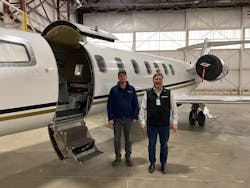Corporate Aircraft to Air Ambulance Transformation
David Fox, owner of Fox Flight Air Ambulance, and Nick Fraser, Fox Flight Air Ambulances’ director of maintenance, talked about Fox Flight's aircraft and MRO operations in a Dec. 10 edition of the AviationPros podcast.
Fox Flight Air Ambulance's fleet consists of three Learjet 40XR aircraft. The Learjet 40XRs are corporate aircraft and are retrofitted to meet the needs of medical professionals who transport patients. Each aircraft is fitted with four seats, a stretcher and a lab. Fox Flight Air Ambulance bought the Learjet 40XRs used.
"We actually bought aircraft that had about 3,000 hours on them each that were personally owned by people," Fox said.
Fox Flight Air Ambulance adds a bigger fuel tank to the aircraft because the company transports patients internationally.
"We upped the amount of fuel the aircraft could take," Fraser said. "I think it's 380-something gallons extra." Adding the extra fuel makes the aircraft weigh about 800 pounds more.
"It goes from 5,200 pounds to roughly just over 6,000," Fox said. The Learjet 40XR configuration is 1,000 pounds lighter than using a Learjet 45, "and being lighter gives us range," Fox continued.
"In a nutshell, we fly patients around the world, generally a lot of Europe to North America, North America to Europe and then in the wintertime, Florida, Caribbean, Mexico," Fox said.
Fox Flight Air Ambulance uses a team of medical professionals instead of paramedics.
"We do our transfers based on hospital bed to hospital bed," Fox said. "We use nurses, physicians, respiratory therapists. Some services use paramedics. We don't because we do transfers internationally and it's all about recognition of qualifications in international transfers of patients."
Fox Flight Air Ambulance flies about 350 patients and 2,400 hours per year. The company plans to transport about 180-190 patients and fly 1,500 hours this year.
Fox Flight Air Ambulance has three aircraft in rotation to make maintenance easier, Fraser mentioned. Two aircraft are ready to fly at all times; the third is put into rotation if one of the other aircraft need service.
To listen to the whole podcast, click the link: AviationPros.com/21165526
